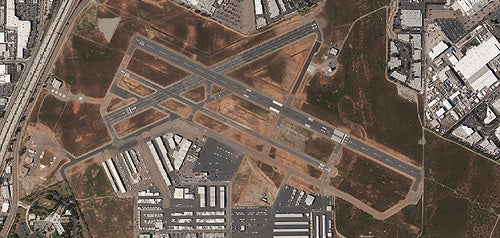Airport Planning and Environmental

Executive Summary
The purpose of the Airport Planning Section of the Airports Division is to properly position Montgomery-Gibbs Executive Airport and Brown Field Municipal Airport to support current and future aviation demand through modernization of airport facilities, using established and innovative airport planning methods.
General Airport Planning
The Airports Division uses a systematic, logical approach to airport planning by identifying what each airport has, needs and wants, then establishing a pathway to get there. This approach ensures airport resources are used effectively in a financially feasible and environmentally responsible manner. Proper airport planning provides additional benefits to airport users and communities, such as enhanced airport safety, efficiency and economic activity. The Airport Planning Section has established the following goals:
- Identify and prioritize airport infrastructure and planning projects.
- Complete Airport Master Planning.
- Update Airport Layout Plans.
- Update Pavement Management Plans.
- Promote compatible land uses consistent with aircraft operations.
- Review proposed off-airport projects located in the Airport Influence Area.
- Coordinate community plan updates with the Planning Department.
- Submit Airport Layout and Master Plans to ALUC for consistency determination.
- Promote and incorporate sustainable practices in airport projects and programs.
- Implement Recycling and Waste Diversion Plans.
- Conduct and implement Airport Sustainability Plans.
- Seek LEED certification for future airport building projects.
- Seek Envision recognition for future infrastructure projects.
- Identify and obtain federal and state funding for eligible airport projects.
- Complete and submit ACIP to the FAA annually.
- Comply with federal reporting requirements.
Airport Master Planning
An airport master plan is a study to determine the long-term development plans for an airport including the extent, type and schedule of development needed. The master planning process considers the needs and demands of airport tenants, users and the general public. The Federal Aviation Administration (FAA) offers a number of objectives as a guide in the preparation of a master plan:
- Understand the issues, opportunities and constraints of the airport.
- Consider the impact of recent national and local aviation trends.
- Identify the capacity of airport infrastructure.
- Determine the need for new improvements.
- Estimate costs and identify potential funding sources.
- Develop a schedule for the implementation of proposed projects.
- Comply with federal, state and local regulations.
In 2017, the Airports Division embarked on a master planning process to define the vision and provide the necessary framework to guide future airport development at Montgomery-Gibbs Executive and Brown Field Municipal airports for the next 20 years. The process included technical studies and was informed by community and stakeholder feedback gathered through a series of public workshops and advisory committee meetings. The resulting proposed airport master plan for each airport includes a report of existing conditions, a forecast of aviation activity, facility requirements needed to accommodate the forecasted aviation activity, development and evaluation of alternatives to meet those needs, an environmental overview and a phased funding plan for that development. The plans also include an Airport Layout Plan (ALP).
Airport Layout Plan (ALP)
The ALP serves as a critical planning tool that depicts both existing facilities and planned development for an airport. Sponsors of airport development carried out at federally obligated airports must accomplish the improvement in accordance with an FAA-approved ALP. By definition, the ALP is a plan for a specific airport that shows:
- Boundaries and proposed additions to all areas owned or controlled by the sponsor for airport purposes.
- The location and nature of existing and proposed airport facilities and structures.
- The location on the airport of existing and proposed non-aviation areas and improvements thereon.
A current FAA-approved ALP is a prerequisite for receiving federal grants for eligible airport development. Sponsors who receive federal grants for airport development are obligated by grant assurance to keep the ALP current at all times.
Airport Capital Improvement Plan (ACIP)
The Airport Capital Improvement Plan (ACIP) serves as the primary planning tool for systematically identifying, prioritizing, and assigning federal funds to critical airport development and associated capital needs for the National Airspace System (NAS). The ACIP also serves as the basis for the distribution of federal grant funds under the Airport Improvement Program (AIP) to airports identified in the National Plan of Integrated Airport Systems (NPIAS). By identifying and investing in airport development and capital needs, the Federal Aviation Administration (FAA) can ensure to the American public that the NAS is a safe, secure, and efficient environment for air travel nationwide.
To remain eligible for future federal grants, the Airports Division maintains and submits a five-year ACIP to the FAA annually for projects identified through the master plan process and placed on an FAA-approved ALP.
Airport Compatibility
The San Diego County Regional Airport Authority (Authority) is the operator of San Diego International Airport and the Airport Land Use Commission (ALUC) for all airports in San Diego County. As such, the Authority is responsible for creating Airport Land Use Compatibility Plans (ALUCPs) for Brown Field Municipal and Montgomery-Gibbs Executive Airports, based on each airport master plan and ALP. The City of San Diego adopted an Airport Land Use Compatibility Overlay Zone to implement the adopted ALUCPs. The Airports Division coordinates closely with the Authority and City departments to ensure off-airport land uses surrounding each airport are compatible with airport flight operations.
Airport Environmental
Montgomery-Gibbs Executive and Brown Field Municipal Airports host significant environmental resources alongside the aeronautical facilities intended for aviation operations. The Airports Division maintains a challenging balance between environmental stewardship, aviation safety and regulatory compliance. To that end, the Airport Environmental Section has established four goals:
- Assess and mitigate wildlife hazard risks to aviation operations at each airport.
- Complete Wildlife Hazard Assessments/Site Visits.
- Complete and implement Wildlife Hazard Management Plans.
- Educate airport users and staff on proper wildlife management techniques.
- Identify and pursue wildlife hazard mitigation projects to reduce any hazards identified.
- Manage sensitive biological resources at the airport.
- Establish an Airport Environmental Education Program (AEEP).
- Inventory and map all sensitive airport biological resources.
- Create an Airport Resource Management Plan.
- Participate in the Vernal Pool Habitat Conservation Plan’s Mitigation and Monitoring Program.
- Coordinate regulatory requirements and compliance in accordance with the California Environmental Quality Act (CEQA) and National Environmental Policy Act (NEPA).
- Coordinate CEQA reviews with various City departments.
- Coordinate NEPA reviews with the FAA and other applicable state and federal environmental resource agencies.
- Fulfill environmental mitigation commitments.
- Identify and coordinate mitigation requirements for past and future airport projects.
- Identify, coordinate and secure mitigation property.
- Establish, maintain and monitor mitigation sites, as required.





Wildlife Hazard Site Visit (WHSV)
A Wildlife Hazard Site Visit is an abbreviated analysis of an Airport’s wildlife hazards to determine if a Wildlife Hazard Assessment is warranted and, if necessary, provide information and suggestions on how the airport could mitigate these hazards. For non-certificated airports that do not currently have a Wildlife Management Plan, a WHSV can provide a suitable basis to develop a simplified plan. The FAA recommends that a WHSV be conducted by a Qualified Airport Wildlife Biologist.
Wildlife Hazard Assessment (WHA)
A Wildlife Hazard Assessment (WHA) is a baseline ecological study conducted by a Qualified Airport Wildlife Biologist. It analyzes the local and transient wildlife populations, habitat, airport operations and wildlife strike data to establish a scientific basis for the development and implementation of a Wildlife Hazard Management Plan. The WHA provides baseline data and risk analysis of wildlife hazards to aviation and proposes methods and strategies for mitigation of those hazards.
Wildlife Hazard Management Plan (WHMP)
A Wildlife Hazard Management Plan (WHMP) describes the comprehensive mitigation measures the airport will take to reduce and remove wildlife hazards from its airfields. The goal of an airport’s WHMP is to minimize the risk to aviation safety, airport structures or equipment, or human health posed by populations of hazardous wildlife on and around the airport.

